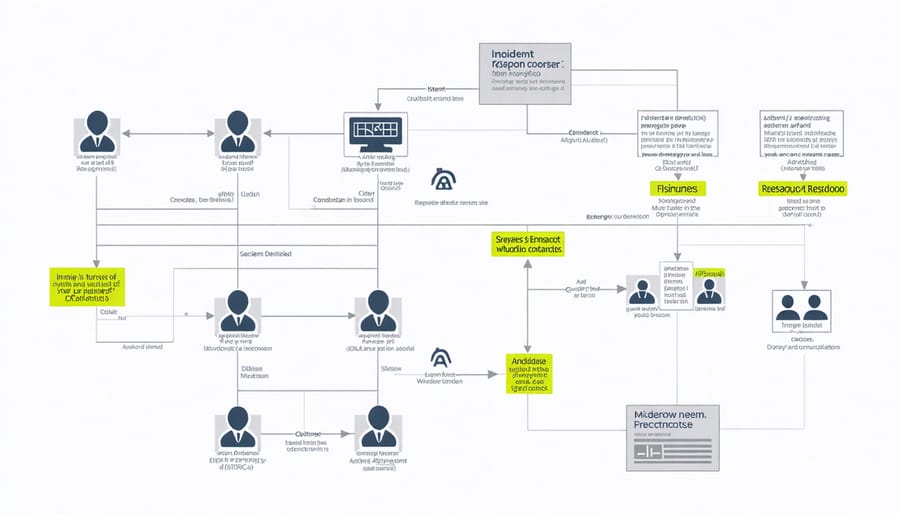
Safeguard your small business’s digital assets with FTC-compliant cybersecurity measures that protect both your company and customers. Data breaches cost small businesses an average of $200,000 per incident, yet implementing robust security protocols remains surprisingly affordable and straightforward. The Federal Trade Commission provides clear guidelines specifically designed for small business owners, helping them navigate cyber threats without requiring extensive technical expertise or massive budgets.
Start with fundamental protections: secure password policies, regular software updates, and employee training form your first line of defense. These core measures, combined with data encryption and regular security assessments, create a comprehensive shield against common cyber threats. Understanding and implementing FTC cybersecurity recommendations not only protects your business but also builds customer trust and demonstrates regulatory compliance.
This guide breaks down essential FTC cybersecurity requirements into practical, cost-effective steps that any small business owner can implement today.
Protecting your customers’ payment information is crucial for maintaining trust and complying with FTC guidelines. Implementing secure payment processing systems starts with following Payment Card Industry Data Security Standard (PCI DSS) requirements.
Create strong access controls by limiting payment data access to authorized personnel only. Use point-to-point encryption for all card transactions and ensure your payment terminals are EMV-compliant. Regularly update your payment software and maintain proper network segmentation to isolate payment systems from other business operations.
Train your staff on proper payment handling procedures, including:
– Never storing complete card numbers
– Using secure, encrypted connections for all transactions
– Properly disposing of paper receipts
– Recognizing and reporting suspicious activity
Consider partnering with reputable payment processors who specialize in furniture retail transactions. They often provide built-in security features and can help ensure your business meets all compliance requirements while protecting sensitive customer data.
Regularly assess your payment security measures and document all procedures. This helps demonstrate due diligence and ensures consistent protection of customer information across all payment channels.

In the furniture repair and restoration business, customer design files contain valuable intellectual property and sensitive specifications that require robust protection. Implement secure cloud storage solutions with strong encryption for all digital design files, custom furniture plans, and client specifications. Create a systematic file naming convention and organize documents in password-protected folders with restricted access limited to authorized personnel only.
Regular backups are essential – maintain at least three copies of all design files, including one off-site backup. When sharing designs with clients or contractors, use secure file transfer protocols and avoid sending sensitive information through regular email. Consider implementing watermarks on digital designs to prevent unauthorized use.
For physical design documents, maintain a secure filing system with controlled access. Establish clear procedures for document handling, including proper disposal methods like shredding when designs are no longer needed. Train your staff on these security protocols and document all access to sensitive files through a logging system.
Update your client agreements to include clauses about data protection and confidentiality of custom designs. This demonstrates your commitment to protecting their intellectual property while establishing clear guidelines for information handling.

Regular employee security training is essential for maintaining a strong cybersecurity posture in your furniture business. Start by implementing mandatory quarterly training sessions that cover basic security practices, including password management, email safety, and data handling protocols. Ensure all staff members, from showroom personnel to delivery teams, understand how to identify potential phishing attempts and suspicious emails.
Create a structured training program that includes hands-on exercises and real-world scenarios relevant to the furniture industry. For example, practice identifying fraudulent purchase orders or suspicious customer data requests. Document all training activities and maintain attendance records to demonstrate FTC compliance.
Consider incorporating the following best practices into your training program:
– Regular updates on new security threats specific to retail businesses
– Role-specific training for employees handling customer payment information
– Clear procedures for reporting security incidents
– Guidelines for secure remote work practices
– Proper handling of customer information during furniture deliveries and installations
Make training engaging by using interactive elements like quizzes and team exercises. Reward employees who consistently follow security protocols and demonstrate good cyber hygiene. Remember to review and update your training materials regularly to address emerging threats and changing business needs.
Implementing strong system access policies is crucial for protecting your furniture business’s sensitive information. Start by establishing clear protocols for customer data management and system access. Create unique login credentials for each employee and restrict access based on job roles and responsibilities.
Consider these essential practices:
– Require strong passwords that combine letters, numbers, and special characters
– Implement multi-factor authentication for sensitive systems
– Regularly review and update access permissions
– Immediately revoke system access when employees leave
– Maintain detailed logs of who accesses what and when
Train your staff to never share passwords or access credentials, even with coworkers. Set up automatic screen locks and session timeouts to prevent unauthorized access to unattended computers. For remote workers, establish secure connection protocols and require VPN usage when accessing business systems from outside the office.
Remember to document all access policies and review them quarterly to ensure they remain current with your business needs and security requirements.
In the furniture restoration industry, your digital assets are as valuable as your physical tools. These assets include proprietary restoration techniques, custom furniture designs, franchise documentation, and client databases. Protecting these assets requires a multi-layered approach that aligns with FTC cybersecurity guidelines.
Start by implementing a secure digital filing system with encrypted storage for your restoration procedures and design portfolios. Use strong passwords and enable two-factor authentication for all accounts containing sensitive business information. Consider using a reliable password manager to maintain unique, complex passwords for different systems.
Regular backups are crucial for protecting your digital assets. Store backup copies of important documents both on-site and in secure cloud storage. This ensures business continuity even if local systems are compromised. For franchise documentation and client records, implement access controls that limit information availability to authorized personnel only.
When sharing restoration techniques or design specifications with team members, use secure file-sharing platforms rather than email attachments. Create clear protocols for handling sensitive information, including proper disposal of digital files when they’re no longer needed.
Document your intellectual property, including unique restoration methods and furniture designs. While technical protection is important, legal protection through proper documentation and registration can provide additional security for your business assets.
Train your staff on proper digital asset handling procedures. This includes recognizing potential security threats, understanding the importance of confidentiality, and following established protocols for data protection. Regular training updates help ensure everyone stays current with security best practices and FTC compliance requirements.
Having a well-planned incident response strategy is crucial for protecting your furniture business from cyber threats. Start by creating a detailed document that outlines exactly what steps your team should take when a security breach occurs. This plan should identify key personnel responsibilities and include emergency contact information for IT support, law enforcement, and relevant regulatory bodies.
Your response plan should cover four essential phases: detection, containment, elimination, and recovery. Train your staff to recognize potential security incidents, such as unusual computer behavior or unauthorized access attempts. Once detected, establish procedures to quickly isolate affected systems to prevent the spread of the threat.
Include specific steps for documenting the incident, including what happened, when it was discovered, and what actions were taken. This documentation is vital for insurance claims and potential legal requirements. Create a backup communication system, as your primary email or phone systems might be compromised during an attack.
Regular testing of your incident response plan through simulated scenarios helps identify gaps and keeps your team prepared. Schedule quarterly reviews to update contact information and adjust procedures based on new threats or business changes. Remember to maintain an up-to-date inventory of all hardware and software assets, as this information becomes crucial during incident response.
Store copies of your response plan both digitally and in print, ensuring they’re easily accessible when needed. Consider establishing relationships with cybersecurity experts and legal counsel before an incident occurs.

Protecting your business doesn’t have to break the bank. The FTC recommends several budget-friendly security solutions that deliver robust protection without excessive costs. Start with free or low-cost antivirus software from reputable providers, many of which offer special small business editions with essential features.
Implement multi-factor authentication across your business accounts – it’s typically free and dramatically increases security. Use password managers to generate and store strong passwords; many offer affordable business plans starting at just a few dollars per user monthly.
Cloud storage services with built-in security features are another cost-effective solution, often including automatic backups and encryption. Many providers offer scalable plans that grow with your business, starting at reasonable monthly rates.
Consider open-source security tools for network monitoring and vulnerability scanning. These tools provide professional-grade protection without licensing fees, though you’ll want to ensure proper configuration.
Staff training remains one of the most cost-effective security measures. Create basic security protocols and conduct regular training sessions using free resources from the FTC’s cybersecurity portal. Leverage free cybersecurity assessment tools from the FTC and NIST to identify vulnerabilities and prioritize your security investments.
Remember to regularly update your operating systems and software – these updates are free and critical for security. By focusing on these fundamental yet effective measures, you can build a strong security foundation without straining your budget.
Maintaining FTC cybersecurity compliance isn’t just about checking boxes – it’s about protecting your furniture business and your customers’ trust. By implementing strong passwords, regularly updating software, training employees, and securing customer data, you’re building a foundation of security that supports your business growth. Remember that cybersecurity is an ongoing process that requires regular attention and updates. Small investments in security measures today can prevent costly breaches tomorrow. Stay informed about the latest FTC guidelines, conduct regular security assessments, and document your compliance efforts. Your commitment to cybersecurity not only meets regulatory requirements but also demonstrates your dedication to professional excellence and customer protection in the furniture repair and restoration industry.